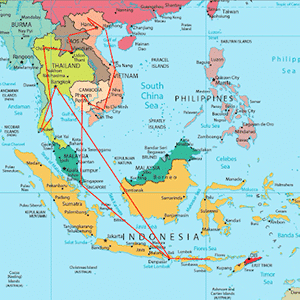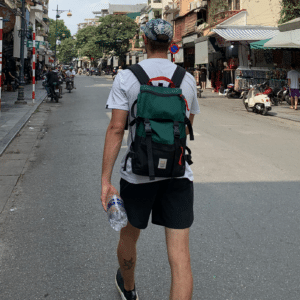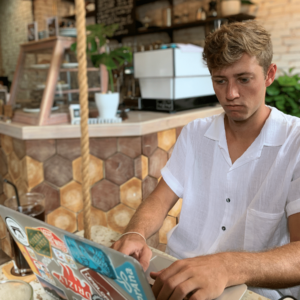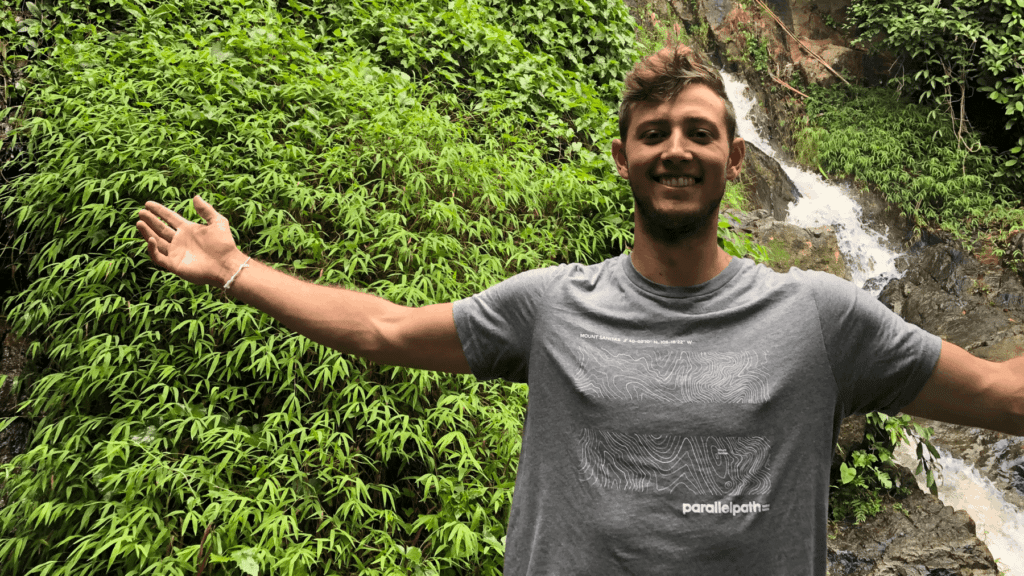The story of how Wyeth Leemon came to be an internationally traveling remote employee began with a round-trip ticket to Bangkok and resignation. But fortunately for both Wyeth and the Parallel Path team, that resignation was turned down and turned into an opportunity for both parties to see if a remote working arrangement could really work.
TL;DR: Working remotely works.
But that’s not surprising. Study after study shows that remote work is beneficial for both employee and business: remote workers tend to be happier than their on-site counterpart employees, and happy employees stay where they are. Remote employees also have fewer distractions. Per Stanford Graduate School of Business professor Nicholas Bloom, requiring employees to be in the office is “outdated,” and that working from home is “a future-looking technology.” A survey he conducted at China’s largest travel agency found that working remotely improved productivity by 13 percent.
We sat down with Wyeth to learn more about his first stint as a remote worker while traveling across Southeast Asia this past summer. We talked about things he learned, tips he has for anyone else with a hankering to test-drive working remotely, and his decision to keep the adventure going.
The Beginning of a Beautiful Friendship
PP: How long have you worked at Parallel Path, and what initially attracted you to the agency?
WL: I have been working at Parallel Path since July 2018. I had heard a lot about Parallel Path during high school and throughout college, because Hardy [Kalisher, CCO] had been my soccer coach during high school and one of my long-time friends had also been interning at “The Path.” So, during my final semester of college, I contacted Hardy to inquire about internship positions the next summer, which turned out to be one of the best things I’ve done to date.
PP: And what keeps you at Parallel Path?
What keeps me at Parallel Path? Wow, where do I begin…well first and foremost, the culture and work environment that we have here is second to none. There is an air of camaraderie and friendship that resonates throughout the office on a daily basis. Everyone comes into the office with a smile on their face and a joke to tell day in day out, which really makes it enjoyable to get up in the morning every day.
Second, the flexibility in terms of office hours, and the option to work remotely when needed is incredible. The fact that they insisted on me picking up some hours from across the globe reinforces that as well.
Finally, the goals and positioning set by John [Kadlic, CEO] have made me want to grow with this company. I thoroughly enjoy working with clients in the health and wellness industry because it gives me peace of mind to know we’re helping companies that have the consumer in their best interest, not just revenue.
Two Tickets to Bangkok, Please!

PP: How did the idea of taking a “half-sabbatical” come to life? What was the start of that thought process like?
WL: The idea to take a “half-sabbatical” started during my senior year of college. My girlfriend and I had always wanted to make a Southeast Asia trip but didn’t have the money to do it right out of college. So we decided we would go home to Boulder, find jobs, and work for a while until we had the financial means necessary to do a 3-4 month backpacking trip, which led me to Parallel Path. After locking down a job, we got a year lease with some other friends and settled in. I ended up working as a server at Proto’s Pizza a few shifts a week on top of working full-time at Parallel Path, which ended up being so worth it in the long-run. Now that we both had jobs, we set our minds to saving up enough for the trip we had been envisioning. The best thing we did in preparation for the trip was to sign up for a flight tracker that sent us emails whenever tickets were unusually cheap. Around March, we got an email with an insane deal for round-trip tickets out of Bangkok and just went for it. Then came the hard part: how would I tell Parallel Path?
“You Have a Laptop, Don’t You?”
PP: How did you broach the subject with your manager at Parallel Path? How was it received?
I was extremely nervous about telling Bryan [Boettiger, COO] that I was going on a 3.5 month trip throughout SE Asia, but he met the news with enthusiasm, confidence, and understanding. Originally I had planned to resign from Parallel Path, but I wanted to give Bryan and the team enough time to find a replacement for me, so I told him my plans a little over a month in advance. Both John and Bryan were extremely grateful for this, which made me feel a lot better about the whole thing. So, my “resignation” was taken exceptionally well by my managers, seeing as it wasn’t really a resignation. I called Bryan early one morning to explain my situation, and he said: “How about working remotely?” I replied, “Um, how’s that gonna work?” All he said in response was: “Well, you have a laptop, don’t you…..?”
And that was that. In the weeks that lead up to my departure, I worked with Bryan and John to figure out which clients I would take care of and how many hours a week, I would be responsible for. The transition was seamless.
PP: Let’s talk about your epic adventure: how did you choose the places you visited? What are some destinations that didn’t make the cut?
WL: We visited many parts of Thailand (including volunteering for a week at The Elephant Nature Park in Chiang Mai), Laos, Vietnam, Cambodia, Singapore, and Indonesia.
We wanted to go to Australia for the last month of our trip, so we kind of sped through the second half of Vietnam and missed a couple of incredible places (which ended up our biggest regret of the trip). When we started planning our Australia trip once we were in Cambodia and had committed to leaving Vietnam, we came to the sad realization that it was going to be far too expensive. So, we bagged it, went to Singapore for a couple of days instead, and finished out the last month of our trip in Indonesia.
There wasn’t really a “why” to any of the places we visited. We knew we were going to start in Bangkok, and then we figured it out from there. We got a lot of recommendations from other backpackers we met at hostels and made our decisions based on that most of the time. Logistics also played a part, so we’d get to a location, figure out what there was to do there and then base how long we’d stay there on that, and then figure out the most accessible place to aim for next that made sense on our general route. We had a rough outline when we started the trip that included some of the bigger things we wanted to make sure we saw like the Full Moon Party in Koh Pangan and the Elephant Nature Park, but other than that we just figured everything out on the fly. This added a fun and adventurous dynamic to the trip, which we really enjoyed.

Four Tips for Remote Workers
- Do your research.
Finding an acceptable place to work without doing any research into quality cafes/coworking spaces will end in one of two ways. Either you’ll find one right when you walk out of the hostel, and it’ll be great, or you’ll walk around for who knows how long, find nothing workable, get frustrated (or hangry), and finally pick a place that is far from ideal simply because you’re tired of walking around aimlessly. There are plenty of people who primarily work remotely, most of which have put together resources about the best cafes and coworking spaces for digital nomads. - Don’t take the hostel WiFi for granted.
This is related to the point above, but if the hostel, hotel, or Airbnb you’re staying at has fast, reliable WiFi and a somewhat reasonable place to post up and work for a couple of hours, take advantage of it! There is nothing better than being able to roll out of bed and head down to the common room or cafe area of the hostel to bust out some work before heading out to the next waterfall. Utilizing the hostel WiFi and workspace helps save a ton of time during the day, allowing for more time to get your adventure on. However, if there is not good WiFi or workspace at the hostel, refer back to tip No.1 before you head out to get some work done. - Plan your working hours.
What I mean by this is, plan your work schedule following your travel plans and visa versa. If you know you have a big project to take care of, either plan to stay posted up at one place for a day or two longer than expected or put in some extra hours to bust out the task assigned. I also relayed this to my team members so they could give me a couple of additional days’ notice when assigning me a big project. This helped me a lot during the trip because I could plan my days according to the work I needed to get done. If I knew I was going on a four-day motorbike loop where I wouldn’t have very much WiFi, I would crank out a lot of work the couple days leading up to the trip so I wouldn’t drop the ball on anything important. - Take advantage of coworking spaces.
Granted, coworking spaces are much less available than cafes with WiFi, but you are guaranteed good WiFi, comfy chairs, tons of power outlets, and a quality, distraction-free work environment. These were hands down the best places to work. I would pay around $2 for 3 hours of WiFi and get a free beverage of my choice, which was the case at most coworking spaces. More times than not, coworking spaces include a cafe and even rooms for rent. If you know you’re going to be in one place for an extended time or have a particularly important project coming up, it is incredibly worth it to pay a little extra to stay at the coworking space. The rooms are slightly more expensive than the average hostel, but they are generally much nicer and you’ll get free access to top-notch WiFi in a comfortable work environment. Most of the coworking spaces I went to had conference rooms and other private work areas that were ideal if you needed a more secluded, distraction-free setting.
Tips for Employers
PP: What are some things that employers should keep in mind to help support remote workers?
WL: If there’s one thing that is the most important for the success of a remote worker, it’s having a seamless and assignment tracking system and a solid communication plan and infrastructure in place. In our case, Basecamp does this job. While not all remote workers are working from the other side of the world like I was, it is essential to track and monitor all assignments in one place. Basecamp was helpful because I was able to quickly look through all of my tasks and due dates in one place, rather than having to dig through my email to find the things I needed to get done.
Second, having access to Google Hangouts, GoToMeeting, Zoom, or other conference software to hop on calls and, more importantly, to be able to share screens was a crucial factor in my success working remotely.
Working Remotely, for Good
PP: Now, you’ve decided to continue your adventure and move to Florida. What are some of the things that you learned on your trip that you’ll take with you as you start working remotely?
WL: One of the most important things I learned, or I should say developed, was being able to keep myself accountable and on task without a structured office environment around me. I had built the foundation for these skills during college, but they were tested much more while traveling. Although I’ll be working from my home office or one of the many coworking spaces in St. Petersburg, Florida, these skills will be invaluable to my success as a remote worker. It’s extremely easy to get distracted when your manager isn’t sitting across the room from you, but I’m confident this won’t be an issue for me, given my recent experience as a remote worker.
To anyone who wants to give working remotely a try, I’d say go for it! It takes some hard work and courage, but it’s extremely worth it. Also, being able to call yourself a “Digital Nomad” is pretty cool too.

